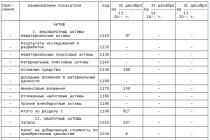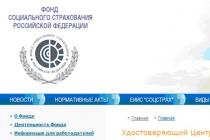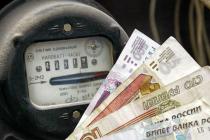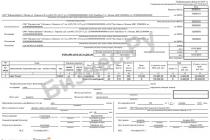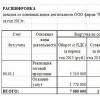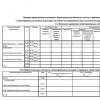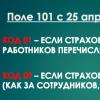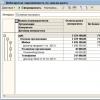Most recently, the legislator allowed us to submit a simplified balance sheet. The Ministry of Finance has developed lightweight forms and in 2013 firms could use them when submitting reports for 2012.
Not all companies can submit a balance sheet in a simplified form for 2016, but only those that are small businesses. This is very convenient, since the balance sheet for small businesses for 2016 may contain a much smaller number of forms compared to the traditional full form of financial statements. A small company can decide for itself what is more convenient for it - a full-fledged report or its simplified version. The chosen method must be reflected in the current accounting policy.
Who submits a simplified balance sheet
In a simplified form, the balance sheet of a small enterprise for 2016 can be submitted. Also, companies participating in the implementation of the Skolkovo innovation project, non-profit enterprises can also use this right.
Small enterprises include legal entities:
- with an average headcount of no more than 100 people. Recall that the average headcount differs from the payroll headcount. The calculation procedure is enshrined in the legislative act of state statistics (Order No. 428 of October 28, 2013);
- whose income from their commercial activities does not exceed 800 million rubles.
- on other grounds contained in clause 1.1. Article 4 of Law No. 209-FZ.
A simplified balance sheet cannot be submitted by companies that have a mandatory audit of reporting (any joint-stock company is included here, since an audit report is necessary for them), building and housing cooperatives, microfinance enterprises, government agencies, notaries, lawyers, parties and a number of others .
How to draw up a balance sheet for a small business
The balance sheet of a small business is formed in accordance with the appendix to Order No. 66n, approved by the Ministry of Finance on July 02, 2010. In addition to the indicators for the reporting year, it indicates the indicators for the previous two years; for this, special columns are provided where data are entered at the end of the year.
The form according to OKUD 0710001 (the balance sheet for small businesses now has exactly this number) is used for reporting for the current year 2016, as well as for 2015. Before that, a different form was used, which was used from 2012 to 2014.
The balance sheet for small businesses 2016 includes two mandatory forms - the balance sheet itself (form 1) and the income statement (form 2). If the company deems it necessary to provide more forms to disclose missing information, then this is allowed.
Companies using the form according to OKUD 0710001 indicate large data without detailing by article, since this form reflects more general indicators and the number of lines in the form is much less.
It doesn’t matter which taxation system the company has chosen, possibly the simplified tax system, everyone, without exception, needs to report to government agencies and draw up annual financial statements.
Regardless of the chosen volume of reporting - full or simplified, compliance with the legislative deadlines for its submission is required. For 2016, rent until March 31, 2017 (Thursday). Significant fines follow if the deadline is missed. Since we submit reports on a mandatory basis to two state bodies - this is the tax inspection and statistics bodies, then the fines are different. In the first case, you will have to pay 200 rubles for each document not submitted on time, in the second case, liability from 3,000 to 5,000 rubles is provided.
When there is no activity, firms must still submit zero reporting, otherwise they will face the same fines.
How to fill in a simplified balance sheet 2016?
For each of the balance lines, indicators are given for 3 years, if any indicator is missing, then a dash is put. The code in the line is affixed depending on whose share in this aggregated indicator is the largest.
Simplified balance sheet: an example of filling
For example, if a company has the most receivables at the end of the reporting period, then the code 1230 is entered in the line “Financial and other current assets” in the balance sheet (see an example of filling out a balance sheet for a small business below).
Simplified balance sheet for small businesses: instructions for filling out
Let's start with Asset balance. It consists of five sections and the balance currency for the Asset section (line 1600). The Asset reflects all the property of the company, which is divided into current and non-current assets.
The line "Tangible non-current assets" reflects data on fixed assets. These can be buildings, structures, vehicles, etc. The balance of accounts 01 and 03 is entered here, minus the balance of account 02, and expenses for construction in progress (account 08) are also added.
The line “Intangible, financial and other non-current assets” forms the value of intangible assets (these include: scientific works, works of art, computer programs, inventions, etc.), balances on deposits are reflected (account 55), long-term investments ( account 58), as well as the debit balance on accounts 60, 62, 68, 69, 70, 71, 73, 75 and 76.
Filling in the line "Inventories" of the simplified balance sheet does not differ from the generally accepted filling of financial statements. The stocks take into account the cost of raw materials and materials not transferred to production, but recorded on the debit of accounts 10, 15, 16, the cost of finished products, reflected on the debit of accounts 43 and 45, the amount of costs for work in progress, recorded on accounts 20,23,29 and so on.
The line “Cash and cash equivalents” indicates the presence of the company's cash in Russian rubles and foreign currency, which are available on the accounts or in the cash desk of the enterprise, as well as cash equivalents. The balance of accounts is reflected: 50, 51, 52, 55 (except for the amounts reflected in lines 1170 and 1240), 57.
The line “Financial and other current assets” displays information on short-term financial investments (account 58), on accounts receivable, presented with VAT, but not accepted for deduction, the amount of excises and other current assets of the organization.
In the currency of the asset, this is line 1600, the sum of all the indicators discussed above is indicated. It reflects all the property of the company.
Simplified balance sheet liability consists of 6 sections and reflects the sources of formation of the company's funds. Sources are in the form of own funds, they are reflected in the line "Capital and reserves" and include information on authorized and additional capital, on the reserve fund and retained earnings. Data on accounts 80 (minus the debit balance of account 81), 82, 83 and 84 are entered here.
Companies also attract borrowed funds, which are recorded in the line "Long-term borrowed funds". Here is the debt on long-term loans and borrowings (account 67). Long-term refers to liabilities with a maturity of more than 1 year. This line reflects the balance of accounts 60, 62, 68, 69, 70, 71, 73, 75 and 76. And there is also “Short-term borrowed funds”, it reflects the balance of account 66.
The name of the line "Accounts payable" fully reveals its essence. It contains the credit balance figures for accounts 60, 62, 68, 69, 70, 71, 73, 75, and 76.
The line “Other short-term liabilities” may well be left blank if all the information is already indicated.
The indicator of line 1700 reflects the total amount of the organization's liabilities. The results of the Asset and Liability must be equal.
An example of filling out a simplified balance sheet

Simplified income statement: sample filling


Download simplified balance sheet
Based on materials from the Modern Entrepreneur website (C)
Home — Documents
Simplified balance sheet
Not later than April 1, 2013, the financial statements for 2012 must be submitted to the Federal Tax Service Inspectorate, which must include a balance sheet. Small business entities, when forming it, have the right to use a simplified form developed by representatives of the Ministry of Finance.
The balance sheet characterizes the financial position of the organization as of the reporting date (clause 18 PBU 4/99).
It provides indicators (Appendix 5 to Order N 66n):
- as of the reporting date (31 December 2012);
- as of December 31 of the previous year (as of December 31, 2011);
- as of December 31 of the year preceding the previous year (as of December 31, 2010).
We remind you that according to paragraph 19 of PBU 4/99, assets and liabilities are reflected in the balance sheet with a division into short-term and long-term. At the same time, assets and liabilities are presented as short-term if the term of circulation (repayment) for them is not more than 12 months after the reporting date or the duration of the operating cycle, if it exceeds 12 months.
All other assets and liabilities are long-term.
Assets
The balance sheet asset for small businesses consists of only five lines:
- tangible non-current assets;
- intangible, financial and other non-current assets;
- reserves;
- cash and cash equivalents;
- financial and other current assets.
note! Small businesses have the right not to calculate such indicators as deferred tax assets, deferred tax liabilities, etc. objects. This is indicated in paragraph 2 of PBU 18/02 "Accounting for settlements on corporate income tax" (approved by Order of the Ministry of Finance of Russia dated November 19, 2002 N 114n).
By line " Tangible non-current assets"reflect both the cost of fixed assets and unfinished capital investments in fixed assets. At the same time, the balance sheet should include numerical indicators in a net assessment, i.e. minus regulatory values (paragraph 35 of PBU 4/99). the initial (current, replacement) cost of fixed assets is the amount of accrued depreciation.A similar rule applies when accounting for intangible assets.
In line " Intangible, financial and other non-current assets"show:
- intangible assets;
- incomplete investments in intangible assets;
- research and development results;
- long-term financial investments;
- Deferred tax assets;
- deferred expenses, etc.
As a rule, organizations have to divide financial investments into those for which the current market value can be determined, and those for which their current market value cannot be determined.
Meanwhile, small enterprises have the right to take into account all financial investments at their initial cost. This conclusion follows from paragraph 19 of PBU 19/02 (approved by Order of the Ministry of Finance of Russia dated December 10, 2002 N 126n). If any costs comply with the conditions for the recognition of a certain asset, established by regulatory legal acts on accounting (PBU 6/01, PBU 5/01, PBU 14/2007, etc.), then they should be shown in the balance sheet as part of this asset (Letter Ministry of Finance of Russia dated November 17, 2011 N 07-02-06 / 220).
How to fill out a general and simplified balance sheet, instructions with line decoding
Otherwise, such costs are recognized as deferred expenses. Then they are subject to write-off by distributing them between reporting periods in the manner established by the organization, during the period to which they relate (Letter of the Ministry of Finance of Russia dated January 12, 2012 N 07-02-06 / 5). Deferred expenses appear in PBU 14/2007 "Accounting for intangible assets" and PBU 2/2008 "Accounting for construction contracts" (approved by Orders of the Ministry of Finance of Russia dated December 27, 2007 N 153n and dated October 24, 2008 N 116n, respectively) .
To the line " Stocks"It is necessary to include not only information about raw materials and materials, but also about finished products, about goods, etc. This conclusion follows from paragraph 20 of PBU 4/99 and paragraph 2 of PBU 5/01 "Accounting for inventories" (approved by Order of the Ministry of Finance of Russia dated June 9, 2001 N 44n).
By line " Cash and cash equivalents"show cash balances and cash equivalents. We are talking about highly liquid financial investments that can be easily converted into a known amount of cash and which are subject to an insignificant risk of changes in value. Such a definition is set out in paragraph 5 of PBU 23/2011 "Report on cash flow" (approved by Order of the Ministry of Finance of Russia dated February 2, 2011 N 11n). An example of a cash equivalent is open demand deposits in credit institutions.
Line " Financial and other current assets" intended for:
- short-term financial investments;
- accounts receivable;
- value added tax;
- other current assets not included in other lines of the balance sheet.
On the line "Financial investments (excluding cash equivalents)" of the "Current assets" section, you should show information on financial investments, the maturity (repayment) for which is no more than 12 months after the reporting date or the duration of the operating cycle, if it exceeds 12 months. This follows from paragraph 41 of PBU 19/02 and paragraph 19 of PBU 4/99. For VAT, they show the balance of account 19 (it is possible when carrying out export operations, with a long production cycle, etc.).
Passive
The balance sheet liability is formed by the following indicators:
- capital and reserves;
- long-term borrowings;
- other long-term liabilities;
- short-term borrowings;
- accounts payable;
- other short term liabilities.
By line " Capital and reserves"show authorized capital, additional capital, reserve capital, retained earnings (uncovered loss), etc. This consolidation is very logical, because small businesses have the right to use account 80 "Authorized capital" instead of accounts 80, 82 and 83 (clause "b" clause 3.2 of the Information of the Ministry of Finance of Russia N PZ-3 / 2012).
At the same time, it should be borne in mind that the balance sheet reflects the amount of the authorized (share) capital registered in the constituent documents (clause 67 of Order No. 34n). This indicator does not depend on the debt of the founders on deposits.
As part of the additional capital, they reflect the difference resulting from the conversion into rubles of the value of the organization's assets and liabilities denominated in foreign currency used to conduct activities outside the Russian Federation. This is indicated in paragraph 19 of PBU 3/2006 "Accounting for assets and liabilities whose value is expressed in foreign currency" (approved by Order of the Ministry of Finance of Russia dated November 27, 2006 N 154n).
When calculating the indicator "Retained earnings (loss)", the balance of account 99 "Profits and losses" is summed up with the balance of account 84 "Retained earnings (uncovered loss)". Debit is loss, credit is profit. In this case, the loss is reflected as a deductible indicator in parentheses. Recall that the decision on the distribution of net profit or on the repayment of losses is the competence of the general meeting of participants in the company (clause 11, clause 1, article 48 of the Law of December 26, 1995 N 208-FZ and clause 7, clause 2, article 33 of the Law dated February 8, 1998 N 14-FZ).
In line " Long-term borrowings" reflect the debt on loans and borrowings, the maturity of which at the reporting date exceeds 12 months. In accordance with paragraph 73 of Order N 34n, this debt is reflected taking into account interest payable at the end of the reporting period.
In turn, for short-term loans and borrowings, the line " Short-term borrowings". If the maturity of borrowed funds previously presented in the balance sheet as long-term liabilities at the reporting date is less than 12 months, then these liabilities are presented as short-term. This conclusion was made in the Letter of the Ministry of Finance of Russia dated January 28, 2010 N 07-02- 18/01.
It is important! Small enterprises (with the exception of issuers of publicly placed securities) have the right not to reflect estimated liabilities, contingent liabilities and contingent assets in accounting (clause 3 of PBU 8/2010).
By line " Other long-term liabilities" reflect deferred tax liabilities (if the company keeps records in accordance with PBU 18/02), long-term estimated liabilities, etc.
At the same time, it should be taken into account that contingent liabilities and contingent assets are not recognized in accounting, but information on them must be shown in financial statements. This is indicated in paragraph 14 of PBU 8/2010 "Estimated liabilities, contingent liabilities and contingent assets" (approved by Order of the Ministry of Finance of Russia dated December 13, 2010 N 167n). The estimated liability is taken into account on account 96 "Reserves for future expenses" (clause 8 of PBU 8/2010). The most reliable estimate of expenses is the amount required directly to fulfill the obligation as of the reporting date or to transfer the obligation to another person (Letters of the Ministry of Finance of Russia dated August 17, 2012 N 07-02-06 / 205 and dated January 27, 2012 No. N 07-02-18/01). For example, estimated liabilities are the obligations of the organization in connection with the emergence of employees' right to paid holidays (Letter of the Ministry of Finance of Russia dated April 19, 2012 N 07-02-06 / 110).
In turn, the amount of the estimated liability in the event of the execution of obviously unprofitable contracts is determined as the smallest of two values - the excess of the inevitable costs of the implementation of such a contract and the expected income from it, or as the amount of sanctions for terminating the contract. This conclusion was made in the Letter of the Ministry of Finance of Russia dated January 27, 2012 N 07-02-18 / 01.
By line " Accounts payable" show short-term debt to suppliers, employees, budget, etc.
In line " Other current liabilities" take into account other short-term liabilities that are not included in other lines of the balance sheet.
February 2013

Not all companies need to keep accounting records. However, every enterprise needs to submit reports, however, a simplified form has been created for small businesses. For example, only 11 lines remain in the balance sheet: 5 for assets and 6 for liabilities. In addition to it, you need to fill out a report on financial results and submit these 2 documents to the tax service and Rosstat before March 31.
Reporting to the state on the results of activities is the duty of any enterprise (Federal Law of December 6, 2011 N 402-FZ). And this must be done in a timely manner. Failure to submit reports entails fines and increases the likelihood of a tax audit.
Small Business Reporting
Accounting requirements are given in the Federal Law of December 6, 2011 N 402-FZ. The basis of financial statements is the balance sheet and income statement. It is also necessary to draw up an explanatory note, if necessary.
The financial statements of small enterprises can be complete or simplified.
The simplified form can be used:
- small business;
- non-profit organizations.
This can only be done if the field of activity is not on the list of exceptions. In particular, the firm does not apply to microfinance companies, legal advice, notary and law firms.
Criteria for small businesses
Companies are classified as small businesses if:
- their revenue without VAT for the last calendar year amounted to up to 800 million rubles;
- the average number of employees did not exceed 100 people;
- the share of the state, funds, large companies up to 25%.
Rice. 1. Small business
At the same time, it does not matter at all what system of taxation the company applies, because. only requirements for financial reporting and accounting depend on this status. Tax accounting is different.
However, in 2015 all simplified enterprises are automatically equated to small businesses. It's simple: in order to apply the simplified tax system, revenue should not exceed 64 million rubles. per year and this value is included in the limit of 800 million rubles. But, again, if the company is suitable for the share of the state / funds. The composition of the founders in this matter is important.
The status of a small enterprise is assigned to a company if, for three consecutive years, it meets the criteria listed above. For example, 2013, 2014 and 2015 For a company to be classified as a small business, you do not need to submit any documents anywhere.
If the company has just registered, then in the first year, subject to the limit on operations, the number of employees and the appropriate composition of the founders, then the company automatically refers to a small business.
Accounting documents
Small companies can generate reports according to a simplified scheme. But they also have the right to do so on a general basis. Each company decides this issue independently. In addition, the form can be developed independently.
In both cases, 2 documents must be submitted (download the reporting form for 2015):
- balance;
- statement of financial results (earlier - income statement).
The difference between them lies in the need for detail. In a simplified version, you do not need to paint everything according to the articles, in general it is necessary to do this. In the first case, a simpler form, in the second it is more complicated.
Before filling out the documents, it is necessary to make final entries for the year, close all company accounts.

Rice. 2. Small business balance sheet
For comparison: the full form of the liability section “V. Short-term liabilities of OAO Gazprom for 2014.

Rice. 3. Example of one section of the full form
In the simplified form, unlike the full one, there is only one line.

Simplified financial statements: who delivers
4. Form of the income statement
If you need to specify additional information, without which it is impossible to assess the financial condition of the organization, or you need to disclose the principles of accounting policies and other important information, make up an application.
How to fill out forms
The basis for filling out forms is accounting data. Before filling, you must make all the transactions and close open accounts (download the completed example).
Changes cannot be made. If it is not possible to enter the necessary information in a simplified form, a general form should be used.
Errors can be corrected. How to do this is described in the video:
When aggregating indicators, the line code must indicate the one from the group whose share is larger.
To whom to report
If an enterprise is registered after September 30, then it must report not in the next year, but in a year and for the entire period from the start of business.
You need to report for the year, you do not need to fill out intermediate forms. But you can do this for self-examination or at the request of the company's management.
Reporting is required to 2 authorities:
- tax office;
- Rosstat.
Note: For small businesses, accounting can be done independently (saving on an accountant) using the My Business Internet service.
Pyotr Stolypin, 2015-09-05
Questions and answers on the topic
No questions have been asked for the material yet, you have the opportunity to be the first to do so
Simplified accounting (financial) reporting
Economic entities specified in Part 4 of Art. 6 of the Federal Law of 06.12.2011 N 402-FZ "On Accounting", they can generate financial statements according to a simplified system or in the generally established manner (clause 6 of the Order of the Ministry of Finance of Russia of 02.07.2010 N 66n). The relevant decision is made by the organizations themselves.
An organization applying simplified accounting methods, including simplified accounting (financial) statements, may:
— draw up accounting statements in a reduced volume (balance sheet and income statement - for a commercial organization; balance sheet and report on the intended use of funds - for a non-profit organization). In particular, the issue of including the statement of changes in capital and the statement of cash flows in the financial statements is determined by the need to bring in the appendices to the balance sheet, income statement, report on the intended use of funds the most important information, without knowledge of which it is impossible to assess the financial position organization or financial results of its activities (clause "b" clause 6 of the Order of the Ministry of Finance of Russia of 02.07.2010 N 66n, clause 26 of the Information of the Ministry of Finance of Russia of 06.29.2016 N PZ-3 / 2016);
- use simplified forms of the balance sheet, income statement and report on the intended use of funds (clause 6.1 of the Order of the Ministry of Finance of Russia dated July 2, 2010 N 66n, clause 27 of the Information of the Ministry of Finance of Russia dated June 29, 2016 N PZ-3 / 2016).
Balance sheet for small businesses (features)
If the organization does not apply these forms, then in the balance sheet, income statement, report on the intended use of funds, it can include indicators only for groups of articles (without detailing the indicators for articles) (clauses "a" clause 6 of the Order of the Ministry of Finance of Russia dated 02.07.2010 N 66n, p. 27.1 of the Information of the Ministry of Finance of Russia dated 06.29.2016 N PZ-3 / 2016).
Attention! Religious organizations that did not have an obligation to pay taxes and fees for the reporting (tax) periods of the calendar year are not required to submit annual accounting (financial) statements to the tax authority
Simplified accounting (financial) statements (KND 0710096) >>>
Simplified form of balance sheet (OKUD 0710001) >>>
Simplified form of the income statement (OKUD 0710002) >>>
Simplified report on the intended use of funds (OKUD 0710006) >>>
The value of the indicator of line 2120 "Cost of sales" (for 2015) was determined by the accountant on the basis of data on the total debit turnover for 2015 on the sub-account "Cost of sales" of account 90 "Sales" in correspondence with account 20 "Main production". The cost of services rendered in 2015 amounted to RUB 634,943. The accountant transferred the indicator of line 2120 of the previous year from the Statement of Financial Results for 2014: - 205,000 rubles. The organization has not raised any borrowed funds. There is no income in the form of interest received, respectively. Therefore, line 2330 "Interest payable" of the Statement of Financial Results is not filled out. There are no other incomes and other expenses in the organization. Therefore, lines 2340 "Other income" and 2340 "Other expenses" of the Statement of Financial Results are not filled.
Small Business Accounting
At the same time, with the final entry in December, the amount of net profit of the reporting year was written off from account 99 “Profits and losses” to the credit of account 84 “Retained earnings (uncovered loss)”: Debit 99 subaccount “Net profit (loss)” Credit 84–306,057 rubles. (326,057 rubles - 20,000 rubles) - net (undistributed) profit of the reporting year was written off. After reflecting all business transactions in accounting, the accountant received the following data on turnover in accounting accounts for 2015: Table 3 Account Turnover for 2015, rub.
Debit Credit 90 “Sales” subaccount “Revenue” 961,000 90 “Sales” subaccount “Cost of sales” in correspondence with account 20 “Main production” 634,943 99 “Profit and loss” subaccount “Single tax expense” 20,000 99 “Profits and losses” in correspondence with account 84 “Retained earnings (uncovered loss) 306,057 Table 4 Name of indicator Code For 2014, thous.
Error 404
Attention
Based on the results of the completed lines, the final result for assets and liabilities is calculated, after which these two values are compared. You can download a sample balance sheet for small businesses for 2014 at the end of the article.
Sample filling in the report on financial results (profit and loss) For each line of the report, you must specify data for the reporting year and for the same period of the previous year. The heading of the report is filled in similarly to the income statement form 2.
The profit and loss statement itself contains the following lines: Volume of proceeds - income from core activities, from which VAT and excise tax are deducted (export customs duties should not be deducted). Expenses for core activities - the volume of all expenses for entrepreneurial activities without division into cost, administrative and commercial expenses (deductions and minus indicators must be indicated in parentheses).
Online journal for an accountant
Name of organization LIMITED LIABILITY COMPANY "SPORTMASTER" TIN 7728551528 Code of type of economic activity according to OKVED classifier 52.42.1 Code according to OKPO 77522772 Form of ownership (according to OKFS) 23 - Ownership of foreign legal entities Form of incorporation (according to OKOPF) 65 - Type of report 2 - Full Unit of measurement 384 - Thousand rubles
- Balance sheet
- Income statement
- Statement of changes in equity
- Cash flow statement
Reporting for other years Zero lines are hidden for the convenience of reporting reporting Print Download dossier on SPORTMASTER LLC Balance sheet Name of indicator Line code As of December 31, 2015 As of December 31, 2014 Asset I.
Simplified reporting for small businesses
Alfa's accounting policy provides that revenue is determined as money is received from customers, expenses are recognized as payment is made and reduce the financial result of the current period (clause 7 PBU 1/2008, clause 12 PBU 9/99, clauses 18 and 19 PBU 10/99). The expenses of the organization in 2015 amounted to:
- salary - 150,000 rubles.
(actually paid on hand 100,000 rubles); - Personal income tax - 14,943 rubles. (actually transferred personal income tax to the budget);
- insurance premiums - 119,700 rubles. (actually paid 50,000 rubles);
- rent - 230,300 rubles. (actually 70,000 rubles were transferred);
- materials - 150,000 rubles. (actually paid 150,000 rubles);
- depreciation - 250,000 rubles. (fixed assets are fully paid);
- single tax for 2014 - 20,000 rubles.
Completing form 2 of the balance sheet (sample)
And to begin with, we note that not all small businesses can keep simplified accounting and submit simplified financial statements. Exceptions are specified in paragraph 5 of Article 6 of the Federal Law of December 6, 2011 No. 402-FZ.
So, for example, microfinance organizations and companies whose financial statements are subject to mandatory audit (for example, joint-stock companies) will not be able to use this benefit (Art.
Simplified balance sheet for small businesses
5 of the Federal Law of December 30, 2008 No. 307-FZ). We also recall which firms generally belong to small ones. These are companies that meet the criteria listed in Article 4 of Federal Law No. 209-FZ of July 24, 2007. There are three of them:
- the amount of the company's revenue - proceeds from the sale of goods, works or services (excluding VAT) cannot exceed 400 million rubles.

 NewsPermalink
NewsPermalink



